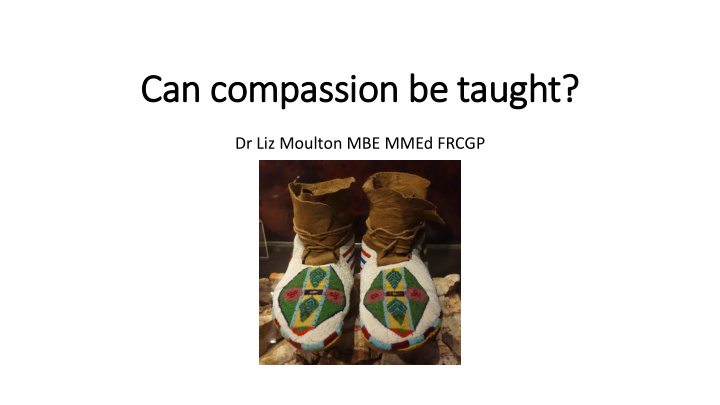



Can compassion be taught? Dr Liz Moulton MBE MMEd FRCGP
About me…. • Freelance GP • GP and GP trainer at College Lane Surgery, Ackworth, for 15 years • Deputy Director of Postgraduate GP Education, Yorkshire and the Humber Deanery • GP Advisor to the Department of Health
Currently… • GP Appraiser • University of Leeds • RCGP - Practice support and development unit • Author - The Naked Consultation The Complete CSA Casebook
Sympathy, empathy and compassion – what’s the difference?
Sympathy, empathy and compassion – what’s the difference? Sympathy = feeling sorrow for other’s misfortunes
Sympathy, empathy and compassion – what’s the difference? Sympathy = feeling sorrow for other’s misfortunes Empathy = the capacity to understand or feel what another person is experiencing from within their frame of reference, that is, the capacity to place oneself in another's position
Empathy equation Empathy = your symptoms + your ICE + your psychosocial (ICE = ideas, concerns and expectations – thoughts, worries and hopes)
“Jane – you’ve had swelling and pain in your finger joints and wrists for the last week or so. You wondered if it might be arthritis, like your mum had and you were worried that it might lead to permanent stiffness and you hoped that I could work out what is wrong, get rid of the swelling and pain and get your hands working again. With your job as a seamstress and caring for your little one as well, I can well understand your concerns. Let’s work out a plan together. “
Sympathy, empathy and compassion – what’s the difference? Sympathy = feeling sorrow for other’s misfortunes Empathy = the capacity to understand or feel what another person is experiencing from within their frame of reference, that is, the capacity to place oneself in another's position Compassion = A strong feeling of sympathy and sadness for the suffering or misfortune of others and a desire to help them Compassion is empathy in action
As health professionals, do we show compassion now?
Can everyone be compassionate?
“Are you going to kill me?” “yes” “Please…please…we can do a deal.. ..I have a lot of money” “So do I” “I have children!” “I don’t want your children” “No!! I have children to take care of” “This will give them something to bond over”
Is compassion important? Just take a moment to think through an experience you have had as a patient (and we are all patients….) and ask yourself if you were treated with compassion – by someone who recognised that you were a person, perhaps in pain or worried or suffering, and who treated you in a way that was personalised and kind.
Compassion makes people better Compassion makes people feel better but it actually makes them get better more quickly as well. And that’s something that we can’t afford to ignore. And it’s not just a hunch or a cuddly feeling – there is evidence from randomised controlled trials (the gold standard of trial) and meta analysis of lots of trials for the following:
Compassion makes people better Being on the receiving end of compassion: - changes physiological responses - reduces pain - reduces revisits to A and E - prolongs survival - improves glucose control - reduces health care costs
How do we show compassion to others? • Empathy • Words • Touch
To Kill a Mockingbird “You never really understand a person until you consider things from his point of view... until you climb into his skin and walk around in it.”
Atticus Finch …Stands on the post office steps and allows Bob to spit in his face and threaten him …He is always friendly to Mrs Dubose (who has terrorised his children) and speaks kindly to her …Places himself between an angry mob and the innocent Tom Robinson with only a newspaper and a light
Barriers to showing compassion • “Professionalism” • Being busy / tired / hungry (HALT) • Compassion fatigue • Patients we don’t like
Ways to improve your patient encounters and demonstrate your compassion • Connect on a human level – not indifferent or detached • Be positive- a positive approach, being honest but not negative • Explain clearly – fully answer questions. Enough information • Help the patient take control • Make a plan with the patient – discuss options, involve patient in decisions. Take account of their views
Recommend
More recommend